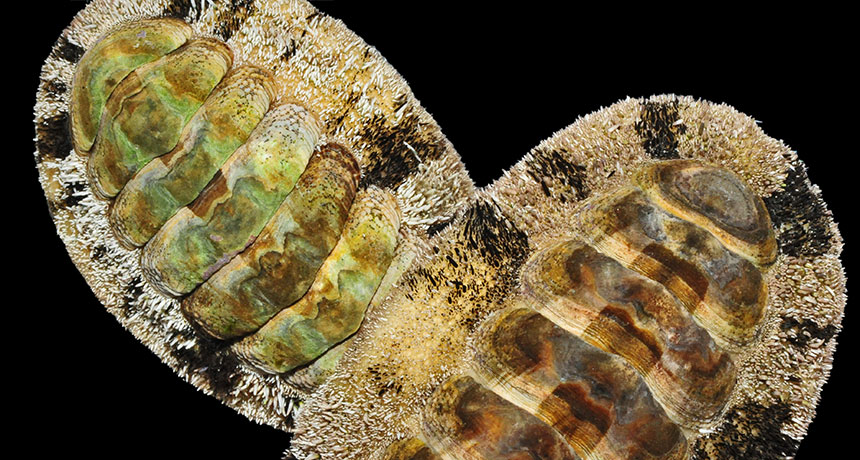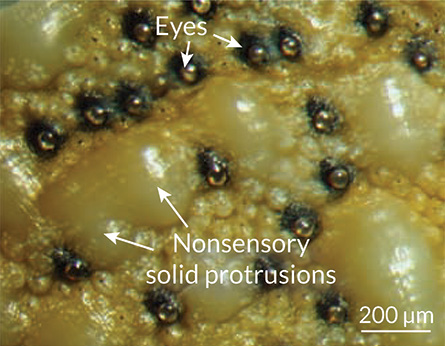How to see with eyes made of rock
A chiton studs its armor with mineral lenses that aid sight but can weaken shell

MOLLUSK MULTITASKING Armored plates of the backs of these West Indian fuzzy chitons not only protect the soft mollusk flesh underneath but also see rough images thanks to hundreds of small, embedded eyes.
Sönke Johnsen/Duke University
Certain species of the crawling lumps of mollusk called chitons polka-dot their armor-plated backs with hundreds of tiny black eyes. But mixing protection and vision can come at a price.
The lenses are rocky nuggets formed mostly of aragonite, the same mineral that pearls and abalone shells are made of. New analyses of these eyes support previous evidence that they form rough images instead of just sensing overall lightness or darkness, says materials scientist Ling Li of Harvard University.
Adding eyes to armor does introduce weak spots in the shell. Yet the positioning of the eyes and their growth habits show how chitons compensate for that, Li and his colleagues report in the November 20 Science.
Li and coauthor Christine Ortiz of MIT have been studying such trade-offs in biological materials that serve multiple functions. Human designers often need substances that multitask, and the researchers have turned to evolution’s solutions in chitons and other organisms for inspiration.

Biologists had known that dozens of chiton species sprinkle their armored plates with simple-seeming eye spots. (The armor has other sensory organs: pores even tinier than the eyes.) But in 2011, a research team showed that the
eyes of the West Indian fuzzy chiton
(
Acanthopleura granulata
) were much more remarkable than anyone had realized. Their unusual aragonite lens can detect the difference between a looming black circle and a generally gray field of vision. Researchers could tell because chitons clamped their shells defensively to the bottom when a scary circle appeared but not when an artificial sky turned overall shadowy.
Now Li and colleagues present more direct evidence of how a chiton sees. They attached a chiton lens to the end of a microscope objective in a water bath. Looking directly through the aragonite lens at a fish-shaped silhouette, the researchers detected a somewhat blurred, but recognizable, shape.
The lens achieves its clarity via tweaks in structure, the researchers found. A chiton lens is made of basically the same material as the unseeing armor around it. But in the lens, the component grains of aragonite are bigger. This means incoming light has to pass through fewer grain-to-grain transitions and less of the material between grains. Reducing grain-to-grain jumps means less scattering of light into a dim haze.
And that’s not all. Grains have orderly internal structures, and the lens grains are more likely to be oriented in directions like those of their neighbors. More harmonious orientations also reduce the scattering of light and preserve clarity in the incoming image.
The chiton lenses may be pretty good, but the small number of light-catching receptors in the retina below the lens probably reduces image quality. Based on the number of receptors, the researchers calculated that each eye could only report the silhouette as a ragged, elongated blur. That blur, however, may be enough for a chiton to recognize an incoming predator.
Other techniques could give a better idea of how receptor cells pick up the image, says visual scientist Dan-Eric Nilsson of the University of Lund in Sweden. He would like to see more analysis, such as direct physiological measurements of electrical impulses jolting through individual receptor cells.
Whatever the eyes see, they introduce weak spots in the armor, Li says. Poking parts of chiton shell with probes broke lenses into sunbursts of spreading radial cracks; the same amount of force didn’t break surrounding armor.
Armor does accommodate those weak spots, Li suggests. The eyes lie in the valleys on the nubbly armor surface. Thus blunt incoming threats probably bang the strong hilltops of the armor before poking the sunken eyes. Also, a chiton grows eyes by the hundreds and keeps producing them as new armor forms along the edges of expanding plates on its back. Eyes crack and erode, but there are lots, and new ones form to continue the vigil.







